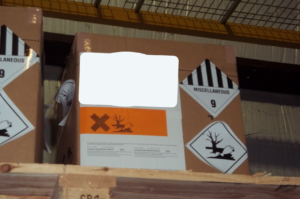(June 26, 2020) A question from a customer of mine:
hi Daniel
I am shipping two boxes of un3077 environmentally hazardous substances, solid., n.o.s. ( dibutyl phthalate), 9, III. This is going ground to Texas. my question is do we have to put the marine pollutant label if its going ground.
I know marine pollutant labels is required for some going ocean. I am also wondering do we have to apply this label if its going air with the class 9.
thanks for your help.
|
Contact me with any questions you may have about the transportation of hazardous materials by air, highway, vessel, or rail International and Domestic Daniels Training Services, Inc. 815.821.1550 |

A non-bulk packaging transported by ground in the U.S. is not subject to regulation as a marine pollutant.
My reply that same day:
Thank you for contacting me. Please see below.
- A marine pollutant is classified by USDOT/PHMSA for transportation within the U.S. as follows:
- It must be identified by name in Appendix B of the Hazardous Materials Table at 49 CFR 172.101 (the Marine Pollutant Table).
- The named marine pollutant must be at a concentration in a solution or mixture of 10% or more for a marine pollutant or 1% or more for a severe marine pollutant.
- The substance must be transported in any packaging (bulk or non-bulk) by vessel or in a bulk packaging by highway, rail, or aircraft.
- Your email does not indicate if the two boxes are bulk packaging or non-bulk packaging. Based on my knowledge of your operations I will presume them to be a non-bulk packaging.
- A non-bulk packaging transported by highway within the U.S. can not be a marine pollutant subject to the Hazardous Materials Regulations (HMR) of the USDOT/PHMSA.
- Also, dibutyl phthalate is not identified as a marine pollutant in the Marine Pollutant Table, so that’s strike three right there.
- Unless subject to the HMR as a hazardous material for some other reason, this substance will not be regulated as a hazardous materials when offered for transport by highway within the U.S.
- You are correct that the classification of a marine pollutant subject to the International Maritime Organization Dangerous Goods Code (IMDG Code) differs from that of USDOT/PHMSA. It is quite possible this substance is a marine pollutant subject to the IMDG Code. More information is necessary to make that classification. If a marine pollutant per the IMDG Code and it does not display any other hazards, e.g., flammability, corrosivity, it will be classified as a Class 9 Miscellaneous.
- If to be transported by air, the Dangerous Goods Regulations of the International Air Transport Association (IATA) will apply. IATA classifies a marine pollutant in the same manner as the IMO, therefore, it is quite possible (more information is necessary to be certain) this substance is a marine pollutant – and therefore a Class 9 Miscellaneous as well – when transportation is by air.
I hope this helps. Please contact me with any other questions.
And that did it!
it does help thank you
